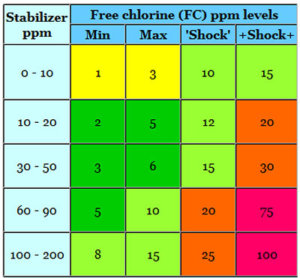FREE Standard Shipping On All Orders $100 or More!*
Fresh Thoughts on Cyanuric Acid

Cyanuric Acid is a pool chemical most commonly sold as stabilizer or conditioner. When added to the pool, it seeks out and attaches itself to chlorine molecules, and forms a protective barrier from the degradation of sunlight. It also slows down the activity of the chlorine molecule in the process, which increases the amount of time for chlorine to remove contaminants.
The Centers for Disease Control in Atlanta went on record several years back, calling for indoor pools to discontinue use of CYA, saying "there’s very strong data showing that cyanurates weaken the disinfection capacity of chlorine".
Cyanuric Acid Reduces Chlorine's Effectiveness
Many health departments have recently increased their minimum free chlorine requirement in public pools, to 2.0 ppm, in an effort to compensate for the effects of cyanuric acid on chlorine. In addition to this, most have strict limits on the levels of CYA that can be used, requiring a facility to drain water from the pool when CYA levels exceed 50 ppm.
When cyanuric acid levels rise too high, it severely hampers the effectiveness or activity of your chlorine. Pools with levels over 50 ppm should drain a portion of the pool water, and dilute with fresh fill water that is not stabilized (test your fill water). Pools with levels over 100 ppm may find it hard to obtain a chlorine reading, a phenomenom known as Chlorine Lock.
Richard Falk, aka ChemGeek, a popular and wicked smart contributor to TFP, has done research around the effects of cyanuric acid on chlorine's effectiveness. From the chart below, it seems that as the level of CYA increases, the level of HOCL, or hypochlorous acid, goes down. HOCL is the stage of life for chlorine where it is a viable disinfectant, and able to sanitize the water by killing contaminants.


To compensate for the suppression of HOCL by CYA, Ben Powell of PoolSolutions recommends raising the Free Chlorine (FC) level in the pool, to maintain proper sanitation. After further research into the issue, and collaboration with Richard Falk, the chart below was created, known as "Ben's Best Guess CYA Chart".
To read the chart, find your level of CYA in the right column, and then move your eyes across the chart to find your recommended Minimum and Maximum for FC levels. The third and fourth column give recommended shock and super shock amounts, for chloramine and algae removal.
Due to the high levels of FC required for sanitation and shocking, it would seem prudent to maintain the CYA level under 50 ppm, if not far less.
Cyanuric Acid Buffers your pH Level

Your pool's pH is also an important player in your chlorine's effectiveness, although unrelated to the level of CYA in the pool. As pool pH rises, chlorine becomes sluggish, to a point over 8.0 where less than half of your chlorine is actively working. A pool with both high CYA and high pH will be very difficult to control contaminants.
However, as Neil Lowry, respected pool chemist points out in his research, CYA buffers pool water to resist downward changes in pH. The reasoning behind this is that CYA makes up part of the carbonates that are measured in a Total Alkalinity test.
But more importantly, a level of CYA in the water reduces the effects of high pH on HOCL levels. According to Lowry, CYA has a buffering effect on HOCL, and in the presence of 30ppm, a pool at a pH of 8.0 has not lost half of it's killing power, but only 15%.
Cyanuric Acid is Complicated
No doubt about it, it's a very unique chemical in the way it gives and takes. Introduced to the pool industry in 1956, it's been around a long time, and just now beginning to be somewhat understood.
For sunny outdoor pools, maintain a level of 20-50 ppm of cyanuric acid. Be sure to test the water with a turbidity test (not a test strip) before adding CYA to the pool, it can be easy to overdose.
Also, keep in mind that Trichlor tablets and Dichlor shock are stabilized, in fact they are over 50% cyanuric acid. For each 50 pounds of stabilzed chlorine that is used, you add 10-20 ppm of cyanuric acid. After a small initial dose of CYA on a freshly filled pool (2 lbs per 10000 gallons), you may not need to add any additional stabilizer.
Over several years of using stabilized tablets, you may find your CYA level creeping above 50 ppm, unless you get a lot of rain, or lower the water every year for winterizing, which dilutes the concentration of CYA. When levels exceed 50 ppm in your pool, drain a portion and refill with fresh, unstabilized water.